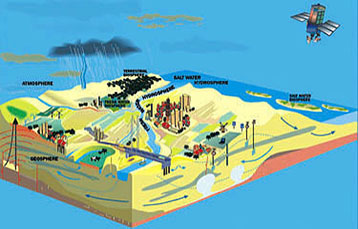Humans in the landscape
Throughout Earth’s history many animals and plants have become geological forces – think of the Great Barrier Reef, or worldwide deposits of coal. Humans are now perhaps the most geologically significant species ever.For example, we now move more material around the Earth’s surface than all natural agents of erosion. Meanwhile our species is depleting soil, water and fuel resources, causing floods and droughts, producing wastes and ‘greenhouse’ gases – disturbing the planet’s dynamic equilibrium. Yet, offering our growing population a secure and prosperous future requires ever more intensive searches for nutrients, energy, water, ores and building materials.
These resources continue to be found as Earth sciences develop their under-standing. All predictions of the exhaustion of such resources have so far proved wildly wrong. There is, as yet, no reason to believe that the Earth will not continue to support our needs – as long as we manage those resources sustainably.
How can we explore and benefit from the planet’s resources without disturbing the proper functioning of the Earth System? We need to integrate our knowledge of the spheres ...

How the ‘geosphere’ interacts with the other spheres of the Earth’s surface. These spheres are artificial academic distinctions; they interact completely within the single entity that is the Earth System.

| Planet Earth in our hands |
|||
| The changing world of Earth Science |
|||
| Spheres within spheres |
|||
| Building high, building deep |
|||
| Fresh groundwater Water is the ultimate resource. Although 70% of the Earth's surface is covered by it, only 2.5% of all water is fresh – of which most is locked in glaciers and permanent snowfields. This leaves only 0.26% of the planet's water available to support humankind. Of this tiny 0.26%, nearly all (>90%) is held in the soil and as groundwater, in the pore spaces of rocks beneath the land. Most groundwater begins as rain that sinks into the ground and collects within permeable rocks, or ‘aquifers’. Our burgeoning population and its various polluting activities pose serious threats to this small volume of fresh water. Moreover as the people of Bangladesh have found out, not all groundwater is drinkable. |
|||